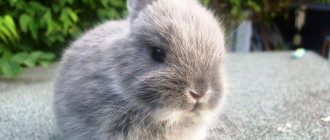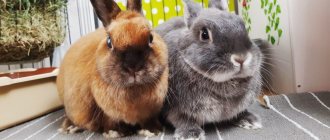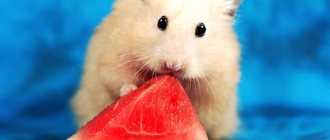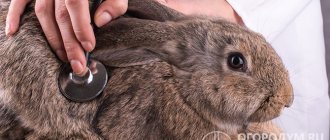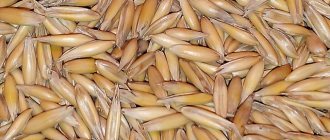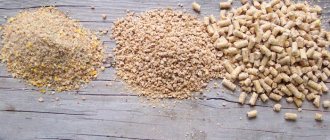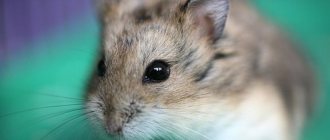Features of the view
Decorative rabbits were bred for indoor use. It is best to buy them in nurseries or from trusted breeders - stores rarely follow the rules for caring for the animal and do not give any guarantees that you will buy a healthy animal.
On sale you can find different types of decorative rabbits - with erect ears, ram rabbits, with red eyes, and so on. The most beautiful breeds are those with long hair, but keep in mind that they require careful care (the fur is combed daily).
Dwarf rabbit breeds are classified by coat length, weight and ear shape.
Ornamental rabbits can also be raised for meat and fur. In this case, fairly large specimens are used.
The life expectancy and health of your pet largely depends on you, or rather on how carefully you comply with the conditions of its maintenance. In general, a decorative rabbit is a breed for the soul; such an animal will become a true friend for the whole family.
What is the difference between decorative rabbits and ordinary ones?
There are many varieties of rabbits. They differ from each other in appearance, weight, size, length of fur and colors. These animals are wild and domestic.
The latter are divided into several types depending on the purpose of breeding:
- Meat. Such animals grow to large sizes, so it is profitable to breed them for dietary meat.
- Fur. Representatives of such breeds can boast of a beautiful coat; they are raised for their skins.
- Downy ones. Bred for fluff. Animal fur does not contain awns, it is delicate and soft. It is used in light industry.
- Decorative. These rabbits are kept as pets, just like cats or dogs.
The main difference between a decorative rabbit and a regular one is its weight and size. The body weight of an adult animal rarely exceeds 3 kg. Rodents that are used in agriculture, especially for meat, weigh on average 3.5-5 kg. And the body weight of Flanders reaches 7-10 kg.
Representatives of decorative breeds have a beautiful appearance. Each has its own characteristics:
- lop-eared;
- the presence of tassels on the ears;
- large round head;
- plush fur;
- miniature size.
Animals that are artificially bred specifically for keeping at home are better socialized. They quickly become attached to their owner and know how to show tenderness. Decorative rabbits are dwarf. The body weight of such rodents varies between 700-1500 g.
Now they are very popular. Children especially love them, because miniature pets evoke affection.
Decorative rabbits cannot be kept outside or on the balcony, unlike ordinary ones. They need a certain temperature, which should range between +17...+25 degrees.
Popular breeds
Let's look at the most popular breeds of decorative rabbits for home raising:
- Lop-eared dwarf Ram - he looks spontaneous and funny due to the original shape of his ears, which seem to form a horseshoe.
How long do dwarf rams live and how to care for them?
article.
- Colored dwarfs - available in a wide variety of colors; they are cute and easy-to-care animals.
- Dwarf foxes have long, very pleasant to the touch fur. The fur color can be white, red or blue.
- Dwarf Angoras have luxurious fur and are especially popular with young children.
Angora dwarf rabbit
- Rex - wide range of colors, plush fur, very pleasant to the touch. An ideal breed for small children.
- Japanese dwarf - can be two-colored.
- Hermelines are white dwarf rodents with red or blue eyes. The fur is short and thick.
Dwarf rabbit Hermelin
Before choosing, be sure to carefully read the characteristics of the breed and consult with the breeder. The fact is that each type of decorative rabbit has its own character, the features of which are best known in advance.
Some breeds like Hermelins are quite aggressive, so they are not worth buying for children.
How to name a pet
For breeding decorative rabbits, the name is the calling card of the pedigree, and it is chosen strictly according to the first letter of the father’s name. With nicknames for other rabbits that are not burdened by a family tree, owners are free to act in accordance with their taste and imagination.
Often the basis is taken from the appearance or character of the pet - Ushastik, Fluffy, Ryzhik, Bandit, Ottoman. As a rule, owners prefer short, sonorous nicknames that are easy to pronounce and easier for the pet to remember - Fima, Monya, Asya, Zheka, Zaya.
Content
Caring for decorative rabbits is quite simple. The animals are clean, do not require much space, tolerate transportation well and do not need daily walks. For high-quality maintenance of a decorative rabbit you need:
- spacious cage - at least 4 times larger than the animal itself;
- plastic tray - the animal’s paws fall through the lattice;
- automatic drinking bowl, feed bowl , manger (hay is stored in them).
The place to install the cage must be warm. The house is cleaned at least twice a month, the tray is washed weekly. You can carry out hygiene procedures more often if you wish.
A rabbit cage should be 4 times larger than the animal itself.
Decorative rabbits do not tolerate bright sunlight and drafts. Take this into account when choosing a location to install the cage.
Keep in mind that animals love to chew on everything, so keep an eye on them when you release them into the wild - otherwise wires, plants, and shoes will be damaged. You can give your rabbits toys - they will be distracted and stop spoiling everything around them. They especially like planks, cardboard, paper boxes, and pieces of fabric. There is usually no need to bathe the animal - rabbits lick their own fur. If you do get it wet, dry it without drafts—the animals catch colds and get sick quickly.
You need to be careful when handling baby rabbits, as their bones are very fragile. Also, decorative breeds are very shy, so proximity to cats and dogs is contraindicated for them (yes, there are exceptions, but it’s better not to risk it).
Under no circumstances should animals be dropped on the floor - such a flight may be the last in their life.
Rules for choosing a cage, house and accessories
Choosing a cage for a rabbit is a responsible process
When choosing a cage, it is important to decide on its size and arrange everything in it correctly so that the animal is comfortable, because this is where it will spend most of its life.
- The correct size of a rabbit cage is the height of a rabbit standing on its hind legs, the length is 3 rabbit leaps, the width is 2 rabbit leaps.
The cage should easily accommodate a house, a litter tray, a drinking bowl, a feeding trough, a hay barn, and still have room for the animal to move freely.
- The correct pallet is plastic, non-slip. The lattice tray injures the feet of rabbits and is inconvenient for them. Plus, plastic makes cleaning very easy.
- The bottom of the cage needs bedding. A rabbit cannot sit on a hard surface for long. This causes him to develop pododermatitis on his paws.
- The litter tray is placed in the corner of the cage and covered with straw, sawdust, and large wood shavings.
- The grain bowl should be heavy so that the rabbit does not tip it over. The best option is made of ceramic or metal, with a stable flat bottom.
- The automatic drinking bowl and hay manger are firmly attached to the bars of the cage so that the pet does not rattle with them.
- A shelter house is necessary to provide privacy for your pet and protect it from stress. This is his private area. It is there that the pregnant rabbit will create a place for her offspring.
- A long-eared pet needs toys to distract him from wires, bars and other objects that are not intended for his teeth. Decorative rabbits love to play with balls, cardboard boxes with holes, and wooden carrots.
Care
On average, decorative rabbits live 7-8 years; long-livers are not found among them. To make the animal comfortable:
- release him from the cage;
- talk, pick up, stroke;
- Disturb the rabbit as little as possible during the day;
- Make sure there is enough clean water and a variety of food in the cage;
- get vaccinated on time (read more about vaccination of rabbits here);
- trim your claws.
Be sure to give your pet a name, preferably taking into account its character and individual characteristics. You can use the names of cartoon characters or human ones. If you bought an animal for your baby, choose a nickname together.
Domestic rabbits are social animals. They need communication and attention. This affects their lifespan.
You need to communicate with rabbits - this way they feel better and live longer.
Hygiene and bathing
Cleaning the cage
If the rabbit hutch is not cleaned, it will become a source of unpleasant odor in the house and cause poor health of the eared pet.
Cleaning is done at least every other day, and preferably daily . During cleaning, the rabbit is allowed to walk or is moved to another cage.
Cleaning consists of a set of simple procedures: removing excess hair and remnants of old food, partially changing bedding and litter, cleaning the drinking bowl and tray. The cage is washed with disinfectants every two weeks, more often in the summer. Experts advise using chemicals more carefully and giving preference to table vinegar to remove heavy stains.
Paper/newspaper and small sawdust should not be used as bedding. Wet litter and its small fragments are dangerous for decorative rabbits. They provoke paw diseases, stomach upset, allergic reactions and conjunctivitis in rodents.
The best bedding for rabbit hutches is hay and large sawdust. The thickness of its layer must be at least 3 cm.
The toilet filler is completely replaced twice a week.
How to trim claws
A rabbit's nails need to be trimmed every 3 weeks.
Once every 3 weeks, the long-eared pet’s claws are trimmed using a nail clipper or tongs, removing 1–2 mm from the tip. No longer needed, blood vessels may be damaged.
If the vessel was touched and blood began to flow, then the damaged claw is treated with hydrogen peroxide.
Bathing
Bathing a rabbit is not an easy job for an owner.
To begin with, it should be noted that the advisability of water procedures for a rabbit is greatly exaggerated . Experts consider this animal to be so timid that it perceives washing as something terrible and experiences enormous stress.
Nature has already taken care of this. First of all, rabbits don't sweat. Secondly, they are very clean themselves. Thirdly, additional water procedures disrupt the protective lubrication of the skin, which has a bad effect on the quality of rabbit fur.
Therefore, the owner should think five times before bathing his eared pet.
Indications for swimming are:
- extreme pollution;
- overheat;
- diarrhea.
A dwarf decorative rabbit can be washed in a sink or basin. The water should be slightly warmer than room temperature. You should not wet the whole rabbit. It is better to limit yourself to contaminated areas only. You should be especially careful with your ears and nose - water should not get on them.
Considering that the rabbit will not be delighted with water procedures, resistance on his part is expected. You will need an assistant to hold the animal or pour water from a ladle while someone else holds it.
It is advisable not to use detergents. But, if you couldn’t do without them, then you need to wash them off with special care so that nothing is left on the fur. Otherwise, the animal may become poisoned by licking itself.
Use a towel for drying. Not a hair dryer! Noise is an additional source of stress, and hot air can burn delicate skin. It is enough to wrap a wet baby in a soft towel and hold him on the sofa or in your arms until he dries.
Diseases
Decorative rabbits can suffer from infectious and viral diseases. The main ones are rhinitis, stomatitis, staphylococcosis, otitis, conjunctivitis. The animals suffer from intestinal disorders, and the active growth of teeth causes them severe inconvenience. A complete list of diseases of decorative rabbits is presented in this material.
It is recommended that decorative rabbits receive vaccinations - and, believe me, they will cost you much less than further treatment.
Competent care and proper feeding will help to avoid diseases. Make sure that the animal’s diet is balanced, otherwise constant diarrhea cannot be avoided.
Stomach upset is caused by weevil-infected dry food, excess fruits and vegetables, moldy bread, sudden changes in feed, gastrointestinal diseases, unsanitary conditions, and viruses. A common occurrence is constipation. Read what to do if your rabbit is constipated here.
In case of diarrhea, you need to disinfect the cage and give the animal a decoction of chamomile. If it doesn't go away for a long time, contact your veterinarian.
It is necessary to monitor the health of rabbits by regularly conducting veterinary examinations.
Features of breeding for sale
Decorative rabbits give birth approximately 8 times a year, but this number may be less. Small breeds begin to reproduce at approximately 6-7 months.
The behavior of a female rabbit that is ready to breed changes dramatically - she rakes the litter into one place and begins to build a nest. For mating, the female is placed next to the rabbit (strictly - the opposite cannot be done).
It is recommended to leave her in the male’s cage for some more time for repeated matings, and then return her back to her house.
After giving birth, the baby rabbits are left with their mother
If the female is not ready to mate, she will thump her hind legs and simply behave aggressively. In this case, the animals are seated and wait for a more favorable moment.
After mating, a pregnant female, after a couple of weeks, when she joins the male, begins to behave unkindly and fights off. This is how they determine whether it is covered or not. The method is not 100%, since some pregnant females also like to mate.
You can carefully palpate the rabbit's body - small rabbits feel like balls. Under no circumstances put pressure on your stomach, especially not too much. Also, pregnant females often develop a voracious appetite. Birth occurs on average 31 days after covering. The baby rabbits are left in the cage with the mother - she feeds and licks them.
